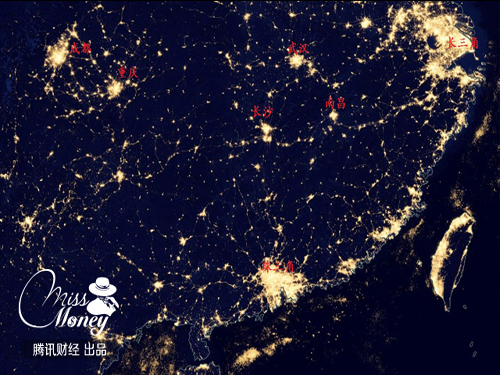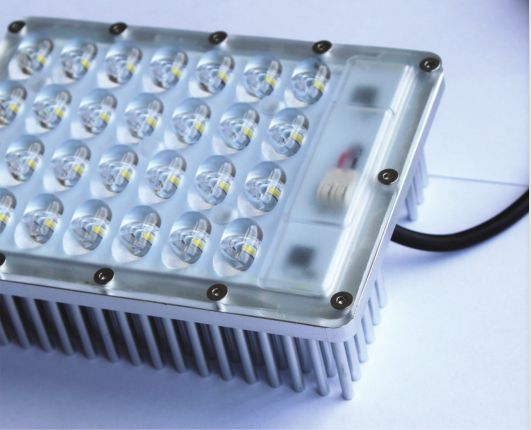
Humanity has created cities with its civilization and wisdom. The most beautiful aspect of the city is the lighting of the night. For economists, there is a huge socio-economic secret behind city lighting. The lights of a city night can not only reflect the population of the city, predict the trend of house prices, but also reflect the economic development of the city.
Elvidge, head of the Earth Observatory team at the National Geophysical Data Center of the United States, said: “You can learn a lot from the night lights of a country’s cities, such as population, economic growth, foreign investment, war and economic recession.â€
For example, the NASA satellite observed the civil war in Côte d’Ivoire between 2002 and 2004. The entire country’s night was dark and the night lights were restored in recent years. In the past 10 years, China’s nighttime lighting has grown in tandem with GDP and population. In contrast, in highly developed countries such as the United States and Western Europe, satellite display lighting patterns have not changed much.
Therefore, the brightness of night city lights is closely related to the degree of urban development. In the first half of this year, the comprehensive research report "Top 60 Cities in China" was released. Here we look at how bright the differences between the first-tier cities and the second-tier cities are through the photos of the nighttime brightness of the Chinese cities in the NASA worldview.
1, Shanghai and the Yangtze River Delta
The Yangtze River Delta is the alluvial plain before the Yangtze River enters the sea, China's largest economic zone, China's most powerful economic center, an important international gateway in the Asia Pacific region, and an important global advanced manufacturing base. The Yangtze River Delta urban agglomeration is one of the six internationally recognized cities in the world.
We can clearly see on satellite maps at night that Shanghai and Taicang and Kunshan in the northwestern provinces of Jiangsu are connected by a weak light, and the northwest border of Shanghai has been covered by light. Although Shanghai's area is not as large as Beijing, it can be seen that the proportion of Shanghai's lighting is larger than the proportion of Beijing's lighting, which has already filled the entire city. Therefore, in the Chinese urban system in 2015, Shanghai ranked first, and Beijing ranked second, both of which were positioned in the first-tier cities.
In addition, in addition to Shanghai in this area, there are Suzhou and Hangzhou. The degree of brightness in Suzhou is greater than that of Hangzhou, and it is almost already connected with the bright areas of Shanghai. In terms of city rankings, Suzhou ranks seventh and Hangzhou ranks tenth.
2. Beijing and Tianjin
The NASA satellite satellite night map shows that the Beijing-Tianjin region is larger than the Yangtze River Delta, but the Beijing-Tianjin region is not even one, and the brightness and area of ​​Beijing's lighting are larger than that of Tianjin. The small city between Beijing and Tianjin is Langfang City. At the same time, in the city ranks, Beijing ranks second, is classified as a super city, Tianjin ranks fifth, was listed as a 1.5-line city.
In 2014, Beijing-Tianjin-Wing integration was proposed. Beijing-Tianjin-Wing Integration includes Beijing, Tianjin and Hebei provinces including Baoding, Tangshan, Shijiazhuang, Handan, Xingtai, Hengshui, Zhangzhou, Qinhuangdao, Langfang, Zhangjiakou and Chengde. Beijing and Tianjin and 11 prefecture-level cities in Hebei Province. With the advancement of the Beijing-Tianjin-Wing integration, we may see in the future that the lights in the Beijing-Tianjin-Wing area will be even one.
3, Guangzhou and the Pearl River Delta
NASA satellite night map shows that the lights of Foshan and Guangzhou are completely integrated. The entire city of Guangzhou can be said to be brightly lit. In fact, Dongguan, Huizhou, Shenzhen, Zhuhai, and Jiangmen have all been in one light. Both Guangzhou and Shenzhen are located in this area, Guangzhou and Shenzhen are in an unusually bright location, ranking third in Guangzhou in the city rankings and Shenzhen in fourth place. Both are listed as first-tier cities.
The Pearl River Delta is China's main area of ​​economic globalization, the country’s scientific and technological innovation and technology research and development base, an important engine of national economic development, and also one of the three major regions with the largest concentration of people, the most innovative ability, and the highest comprehensive strength. "The Pearl of the South China Sea" is called. On January 26, 2015, the World Bank released a report showing that the Pearl River Delta surpassed Tokyo in Japan to become the world's largest urban population and area.
4, the most bright southwest of Chengdu
The night map of the NASA satellite shows that there are two bright and bright pearls in the southwest of China. They are Chengdu and Chongqing. The brightness of Chengdu is obviously greater than that of Chongqing. In the city rankings, Chengdu ranks sixth, Chongqing ranks 9th.
Chengdu has a good environment, a large population, and low labor costs. Currently, there are a large number of electronic technology companies. On the urban area of ​​a single city, Chengdu is also considered to be the top ten. It is probably half the size of Beijing. Chongqing is slightly smaller than Chengdu. In terms of urban area, Chengdu and Chongqing are also considered as big cities in the world. This also illustrates the large scale of Beijing, Shanghai, and Guangzhou.
5, Wuhan, the brightest in the middle
The night map of the NASA satellite shows that there are several pearls scattered in the middle. Most of them are located on the Beijing-Kowloon Railway. From north to south, they are Shijiazhuang, Xi’an, Zhengzhou, Hefei, Wuhan, Changsha, and Nanchang. Among them, Xi'an and Wuhan are relatively bright.
Among these cities, Wuhan ranks the 8th highest, and other cities are all out of the top 10. Only Wuhan and Xi'an are listed as city 1.5.
6, Shenyang, the brightest in Northeast China
Here we turn our attention to the northeastern part of China. There are five prominent pearls in the northeast, which are Dalian, Shenyang, Changchun, Harbin and Daqing Oil City. Except for a few other small points, most of the northeast have no light. Only Shenyang is rated as a 1.5-line city among the four largest cities in the Northeast.
By the way, the Korean peninsula, where the lights are unusually clear, is located in North Korea, except that Pyongyang is bright and the rest of the area is almost black. South Korea is brightly lit and the brightest in Seoul.
The Northeast China, which sits on the largest plain in China, is rich in resources, culturally prosperous, and economically strong, and occupies an important position in the country. When New China was just established, Northeast China, as a heavy industry in China, tends to develop rapidly. However, after the reform and opening up, economic development has been relatively slow.
According to the brightness of the lights, we can also draw the following conclusions: The more light the lights have, the larger the population, the better the infrastructure, the higher the housing prices, the more developed the economy, and the higher the wages of the workers.
The city's strength and weakness rankings are just simple representations of a light. A city needs rapid planning, in addition to diligent urban residents, good natural conditions, and social conditions. It also needs appropriate government planning and appropriate policies. Only relying on image engineering, the development of cities will not be strong.
The unique acicular radiator,360 degree dissipation small wind resistance. High heat dissipation efficiency ensuring that the LED chip can work for 50000 hours.
Color temperature 3000-6000K
Light≥90LM/W
Matching the 2.3.4 lane,tunnel and Landscape Lamp,floodlight dedicated lens.Ensure that intensity and uniformity.
Glare index Signification reduce the original LED Module size,removal of power supply problems.Low demands for application situation and installation personnel More suitable for the transformation of traditional lamps.

Technical parameters
Power :30W,30W,15W,15W
Structure size: 135×100×40 mm, 208×74×49 mm, 125×58×30mm, 380×40×25mm
Lens size: 135×100 mm, 186×64 mm, 125×58mm, 355×40mm
Input voltage: 220 V, 220 V ,220 V, 220 V
Input current: 0.132 A, 0.132 A ,0.123 A, 0.125 A
Luminous flux: 2760 LM ,2400 LM ,1230 LM ,1300 LM
Light effect: 92 LM/W 80 LM/W 82 LM/W 86 LM/W
Color temperature: 5000 K 5000 K 5000 K 5000 K
Power factor: 0.99 PF 0.98 PF 0.98 PF 0.99 PF
Working temperature: -40+50°C, -40+50°C, -40+50°C ,-40+50°C
Led Module,Led Modules For Signs,Led Module Bulb,Led Modules For Signage
Jiangsu chengxu Electric Group Co., Ltd , https://www.satislighting.com